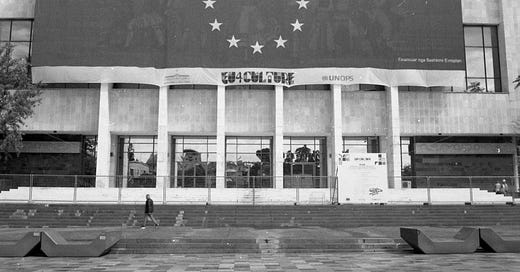Who Struggle for the Humane Treatment of Migrants
An Interview with the Europe Other Collective
Since the fall of the socialist regime in 1990, Albania has experienced a continuous flow of emigration, leading over time to demographic collapse and an ever shrinking and aging population within the country. At the same time, the steady emigration of Albanians to other countries in Europe and intermittent moral panics about their perceived links to criminality have led to wide-spread stigmatization and racist rhetorics, nowadays surfing on the larger waves of nationalism and fascism washing over our continent.
As a country on the edge of the Schengen zone and the European Union – of which it is also a candidate member – Albania has been made complicit in the policing of its borders. Since 2018, officers of Frontex, an organization accused of corruption and human rights abuses, operate with immunity and impunity on Albanian territory, enforcing the EU’s migration policies. And, more recently, the Albanian government has taken on a more active role in mitigating the failures of these policies by facilitating the establishment of multimillion-euro extraterritorial detention centers in Shëngjin and Gjadër, managed by a private company on behalf of the Italian government for the purposes of processing and extraditing “illegal” asylum seekers.
Since the opening of the detention centers, whose processing capacity was planned to be 3,000 people per month, only 24 asylum seekers actually arrived – and left. The first cohort of sixteen migrants was deported to Shëngjin on October 16. Four were returned immediately as they were minors or had health issues, while the twelve others were forced to return on October 18 after an Italian court order. In defiance of the judiciary, the Meloni government then sent another ship deporting eight migrants on November 8. One was sent back immediately, while the other seven left Shëngjin, after another court order, on November 12. Meanwhile, all Italian police officers and care workers employed at the camps have returned to Italy as well, leaving the entire migration deal between the Albanian and Italian governments, between Edi Rama and Giorgia Meloni, in limbo.
I sat down with Kristina and Oriola of the Europe Other Collective, a group of anti-racist activists committed to building resistance against border violence in Albania, which has closely followed the construction of the extraterritorial detention centers and their operation during these past few months.
Your activism around the detention centers in Gjadër and Shëngjin is partially rooted in an understanding of the history of Albanian migration experience in Europe over the last 35 years, in particular with regard to Italy, as a country to which a lot of Albanians emigrated. Could you give me your broad perspective on migration and Albania?
Kristina: This is a very important perspective, because you need to understand the context in which Italy–Albania migrant deal is happening. This deal has a lot to do with neocoloniality, and there are three layers to this. First is the way in which the European Union is using countries in accession talks such as Albania, Serbia, and Bosnia as EU border guards.
The second aspect are the historical relations between Italy and Albania. The deal between Rama and Meloni is promoted as a bilateral agreement between two countries, but we know it is broader than that and the EU is keeping their eyes on Albania and Italy to see whether they can turn it into a blueprint. It is very disheartening to see the rhetoric of our prime minister, saying that it is a moral obligation that we owe to Italy. In the 1990s, when Albanians went to Italy en masse because of the breakdown of the rule of law and the political turmoil, Italy already experimented with boat pushbacks, treating migrants and asylum seekers as a security matter. The Katër i Radës was pushed back and sunk by the Italian naval blockade,1 and after that tragedy the Italian authorities continued and even strengthened their blockade. And now thirty years later Albania is giving away its territory to produce the same violence that our loved ones experienced. This is extremely disturbing, not just to us, but also for example to those who live in Gjadër, some of whom have had family members locked up in detention centers across Europe, and are now reminded of this by the presence of the detention center within their community.
And thirdly, we know from statistics that Albanians remain one of the most frequently deported nationalities by Frontex. Frontex has made a profit out of the misery of Albanians, and now we also become complicit in this violence regardless of our desires, since no one was ever asked about this deal.
Oriola: We should underline the neocolonialism in this deal, also from the perspective of someone who grew up in Italy. My father illegally emigrated to Italy when I was four months. Twice he risked his life to cross by boat. When I told him that Edi Rama said that owe it to Italy, his reaction was shock, surprise, and disappointment all together. Even though many private citizens helped him, he still lived as illegal person for ten years, because it was and still is very hard to get a legal permit in Italy.
Albanians are the fourth largest population in Italian detention centers. So for us, migration issues are personal, they are so close to our lives. Everyone in Albania has someone outside. This is our reality. I have experienced racism all my life, at some point I even stopped speaking Albanian, because I felt too different from the other children. I wanted to feel integrated, so I stopped speaking Albanian or even saying I was Albanian. Growing up I changed my mindset, but it is very weird to me to now hear Italians refer to Albanians as brothers and sisters, as Meloni is doing.
You have followed the construction of the extraterritorial detention centers in Shëngjin and Gjadër from the beginning. How were they built? Who manages them?
Kristina: We’ve undertaken a number of fieldtrips there since the deal was announced and tried to organize some advocacy against it. In April, we went for the first time to Shëngjin, the so-called “hot spot” where migrants disembark and go through identification and screening procedures, after which they are moved to the detention center in Gjadër. Meloni had said the centers would be ready in spring, but there was nothing there, so people lost faith that they would actually be built, thinking that it was pure propaganda.
We talked to some security guards there and in Gjadër, and they told us about the reason for the construction delays, which was a dispute between the Albanian military and the Italian authorities. Apparently, part of the territory used for the detention center in Gjadër was under the governance of the Albanian military and they initially didn’t grant the permission.
As regards the management, there is no signed contract between the Municipality of Rome and the Italian company that got the tender to manage these centers. This company, Medihospes, is actually quite a problematic, monopolistic company managing detention facilities and accommodation structures for migrant workers, and they now also have opened an Albanian branch. And we know that in Albania there is a lot of demand for migrant workers, who are working here under a type of kafala system.2 Scam employment agencies bring migrant workers to Albania on a tourist visa, which cannot be converted to a work visa, but they do this so they can take their money and use them only for the summer season. We have internalized the abuse we experienced as migrants to such an extent that we are now doing it to others.
Through social media you have consistently drawn attention to the illegal nature of the detention scheme. What is the profit of both Albania and Italy to keep up this agreement in violation of international humanitarian law?
Oriola: For companies like Medihospes who profit from disadvantaged people in society, migrants have become big business over the last few years. So there is a lot of economic profit for both sides, especially for Italy, but also Albania. And for Albania, as Kristina already said, there is also the pressure of accession to the European Union that has always been used: the readmission agreement in 2005, the introduction of the biometric passports in 2009 – the government constantly uses this for propaganda. Europe, Europe, one day we’ll enter in Europe. Everyone in Albania is talking about Europe. Every day they wake up and speak about the accession to Europe. In Italy and Europe, no one speaks about Albania, it’s not even a topic.
Kristina: It’s important also to stress the profit that Rama gets out of this. These deals are negotiated behind closed doors. No one even knows who initiated this. But the incentivization of Rama is interesting, because he likely studied the other deals that the EU has struck with Tunesia, Libya, and so on, and we know what you get in return as a political leader when you accept the role of EU border guard. You will get emboldened, and your regime will be even more supported by the EU.
This also happens at an interesting political moment in Albania, with a general fear among politicians now that the Special Structure Against Corruption and Organized Crimes (SPAK) is providing a legal mechanism to hold politicians accountable for all the corruption and money that they stole. And meanwhile Rama is concluding all these agreements that have had a lot of impact, not only nationally but also internationally – with Meloni, with NATO to build the largest NATO airbase in the Balkans in Kuçovë, arms production, the oil shipments to Israel, and the idea of a Bektashi state… As a result he has been treated like a political trophy. He now has the political prestige, is invited at big meetings, summits, in part because of this deal.
You have observed and documented from up close the two trips of the ship Libra deporting migrants to Albania, can you tell me what you have learned about the actual procedure?
Kristina: First of all, it was very emotionally draining as a process to follow and cover. I felt ashamed, I felt angry, I felt disappointed, I was annoyed by Italian journalists, spectacularizing that whole shitshow… Looking at the faces of the migrants and trying to understand how horrible it must be to walk all this time to get to this fucking continent and at the end you end up deported to a place you probably don’t even know, with hundreds of journalists shoving cameras in your face. I remember this journalist asking me, “Do these faces look African to you?” They were not black enough, that was the problem.
Basically, the procedure starts at sea. The migrants are intercepted at international waters, and then they are brought onto this big ship where the selective disembarkation takes place. The International Organization for Migration (IOM) and UNHCR Italy are responsible for assessing all the vulnerabilities, but in both operations they actually failed to do the one job they had. Of course, all of these people are actually vulnerable, but even following their administrative logic how could the IOM and UNHCR fail to identify a person with hallucinations? This person was kept on sea for two or three additional days to be deported to Albania, and then imagine this comprehensive team in Shëngjin doing further checkups finding this was actually a person with hallucinations! How can you not notice this?
So imagine, you are migrant rescued at sea, several extra days making this detour on the naval ship Libra in terrible conditions, without access to showers, and in this first operation there were four of sixteen declared not fit for detention: two of them were vulnerable and two others were minors. So imagine the number of irregularities and how inefficient this whole procedure is. Not only is it inhumane, it is also ridiculous how they failed in all this.
During the first disembarkation at the hotspot at Shëngjin, the group that was declared fit for detention was kept there for thirteen hours. During this period they went through identification procedures, vulnerability screening, and they also had to take the interviews for testimonial gathering for the asylum application. And within 24 hours they even got rejected for their application. Never before in the history of migration and asylum, especially in Italy, did this happen!
They cannot stay overnight in Shëngjin because there are no beds. So after thirteen hours the migrants got transferred to Gjadër with this whole motorcade of Albanian police cars and Italian carabinieri as if they were transporting terrorists. It was like a twilight zone. And then there was the eagerly awaited verdict from the Court of Rome that invalidated their detention.
Access to the detention centers is very limited. It is granted only to the authorities, staff, some international organizations, and the Albanian Ombudsperson, but whenever we approach them they claim to have no time for any inspection visit. There have been some inspections by Italian deputies and representatives of organizations focused on monitoring asylum and refugee rights, and they were quite shocked about the conditions. I have talked to them and they told me that the whole procedure is completely inefficient and inhumane.
What they also told me is that whenever they do these inspections in Shëngjin and Gjadër, the personnel from the naval ship Libra is not present. I have also observed this, that the Libra would always rush to leave after disembarkation, waiting outside the port just in case some minors or vulnerable people would need to be returned to Italy, rather than remaining docked in the port. And I think that the reason they leave so fast is to avoid these inspections. So there is little knowledge about what happens at sea with the screening procedures or the selective disembarkation.
So after the verdict from the Rome Court invalidated the detention, the migrants were transferred back from Gjadër to Shëngjin and there they wait to be picked by an Italian coast guard search-and-rescue vessel. All of this is incredibly costly.
The detention centers are fully built but now empty. Police officers and migration officials have returned to Italy. It’s unlikely they will be filled in the short term. What is the future of the agreement and detention centers?
Oriola: We don’t know what will happen. With these first two disembarkations they wanted to show they are following all the rules, but we know from other countries that they don’t always do that. Look at Greece: there is no European rule of law, there is no god there. So maybe when people will lose interest, they will start to do something else, they will start for real. They just tried, and now they studying what to do next. Because Italy has lost a lot of money on this, and for Meloni it has been a disaster. She lost a lot of support from her people because of the expense and seeing nothing in return. It may be a momentary victory, but this is not over.
Kristina: What can be the potential use of these structures? I think their future is to be turned into deportation hubs, because if you actually check the language of the Rama–Meloni agreement, it is quite vague, speaking broadly about third-country nationals who have this irregularized legal status in Albania. This means that there is also this category of people already in detention centers in Italy that fulfill this criterion, and they may transfer them directly to Albania.
And on the other side, according to a recent Albanian Helsinki Committee report, the Albanian government has submitted ten requests to strike readmission agreements with Pakistan, India, Bangladesh, Egypt, Tunesia, Morocco, and some other countries. This would provide the legal basis for deportation. I got a response to a freedom of information request to the Albanian government some days ago saying that none of them were yet finalized but that “with the help of the European Union” we will!
The Albanian Mechanism is part of Manifesto GREAT WAVE.
The Italian navy sunk the Albanian ship Katër i Radës on March 28, 1997 in the canal of Otranto, killing at least 84 Albanians trying to escape their country.






